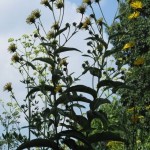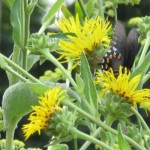 |
 |
Above, left: Elecampane growing in a bed in Bonnefont garden devoted to??medieval vegetables. The bright yellow flowers of this striking plant are borne high on tall stems that can reach an imposing height of six feet. Right: Detail of the fringed flowers, typical of the daisy family. Photographs by Corey Eilhardt.
The tall and showy elecampane (Inula helenium) is a striking presence along roadsides, in pastures, and on waste grounds both in Europe and in the United States, where it is considered an invasive weed by the U.S.D.A., especially in the moist and shady situations it prefers. It is nevertheless still widely planted in ornamental gardens for its imposing height, bold foliage, and bright yellow flowers, which come into bloom at midsummer.
The thick, aromatic rhizome of the plant has been exploited both as a food and a drug for many centuries. The root, described by John Gerard as “sweet of smell and bitter of taste,” yields a starchy, aromatic substance now known as inulin, long thought to be good for the stomach and to aid digestion. Dioscorides records that the root of helenium was dug up in summer and dried for medicinal use; it was then boiled in a decoction, or pounded up with honey, and used to treat cough, convulsions, swellings, and venomous bites (De Materia Medica, Book 1, Chapter 27). The Roman natural historian Pliny the Elder notes that a cheering tonic made from elecampane was taken daily by Julia, the daughter of the Emperor Augustus. Pliny also praises the bitter root as a wholesome digestive, suggesting that it be combined with a syrup made from boiled grape juice, or combined with sweet fruits such as dates and raisins to make it palatable (Historia Naturalis, Book XIX, 91???92.)
Elecampane was as much appreciated by the Anglo-Saxons, who credited it with magical as well as medicinal powers, as it had been by the Greeks and Romans. Hildegarde of Bingen affirms the ancient belief that elecampane was beneficial to the lungs, and the fifteenth-century Herbarius Latinus attests to its efficacy in in clearing the chest of phlegm, as well as soothing and strengthening the heart??and stomach.
The plant’s many virtues are summed up in The Englishman’s Doctor, or the School of Salerne, Sir John Harington’s 1608 translation of the medieval Latin Regimen sanitatis Salernitanum:
Ellecompane strengthens each inward part,
A little loosenesse is thereby provoken,
It swayeth grief of minde, it cheeres the heart,
Allaieth wrath, and makes a man faire spoken:
And drunk with Rew in wine, it doth impart
Great help to those that have their bellies broken.
Elecampane’s use as a food and a sweetmeat is as old as its use as a drug. Dioscorides notes that a liquid made by macerating the dried root in cold water was used by confectioners. There is evidence that elecampane was a staple of the monastic diet in early medieval Ireland, and a fourteenth-century Italian cookbook gives a recipe for a sweet and sour fish dish made with the root. A nineteenth-century source cited by Maude Grieve notes that a candied cake made with elecampane was still available in London in the late eighteenth century. The confection was thought be beneficial for asthma, and a piece was eaten twice daily to open the lungs.
???Deirdre Larkin
Sources:
Allen, David E., and Gabrielle Hatfield. Medicinal Plants in Folk Tradition: An Ethnobotany of Britain and Ireland. Portland and Cambridge: Timber Press, 2004.
Anderson, Frank J., ed. “Herbals through 1500,” The Illustrated Bartsch, Vol. 90. New York: Abaris, 1984.
Davidson, Alan. The Oxford Companion to Food. Oxford: Oxford University Press, 1999.
Grieve, Maude. A Modern Herbal. 1931. Reprint: New York: Dover Publications, 1971.
Grigson, Geoffrey. The Englishman’s Flora. 1955. Reprint: London: J.M. Dent & Sons, 1987.
Gunther, Robert T., ed. The Greek Herbal of Dioscorides, translated by John Goodyer 1655. 1934. Reprint: New York: Hafner Publishing, 1968.
Pliny. Natural History, Vol. V, Books XVII???XIX. Translated by H. Rackham. Cambridge, MA: Loeb Classical Library, 1950, reprinted 1971.
Redon, Odile, Francoise Sabban & Silvano Serventi. The Medieval Kitchen: Recipes from France and Italy. Translated by Edward Schneider. Chicago: The University of Chicago Press, 1998.
Throop, Priscilla, transl. Hildegard von Bingen’s Physica: The Complete English Translation of Her Classic Work on Health and Healing. Rochester, VT: Healing Arts Press, 1998.
Tags: aromatic, daisy, elecampane, inula helenium, inulin, invasive, John Gerard, ornamental

July 22, 2010 at 5:38 pm
Hi Deirdre,
Thanks for sharing this. I read somewhere Elecampane is also a herb species.
Ancient Chinese practice like to use the yellow flower and turn it into medical powders.
Jay Chua
Publisher, PorchSwingSets.com